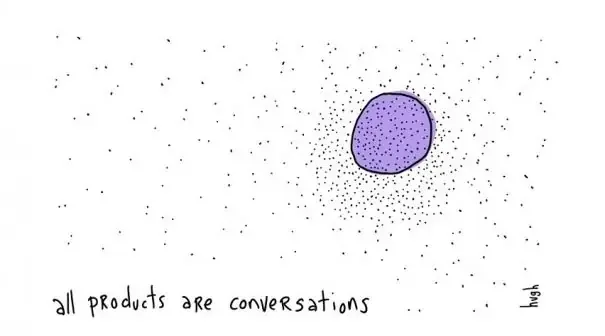Hugh MacLeod, the cartoonist and writer, has a way of distilling big truths into deceptively simple visuals. One of his most enduring pieces features a small, purple sphere surrounded by a cloud of black dots, accompanied by the caption: All products are conversations. It’s a powerful visual metaphor that continues to resonate deeply within the marketing world.

At first glance, this illustration seems minimalist—almost childlike. But its message is profound: no product exists in a vacuum. Every product is embedded in a swirling, ever-expanding network of dialogue. These conversations may occur between a brand and a customer, between two customers, or even among cultural currents that are far beyond a brand’s control.
What Does It Mean That a Product Is a Conversation?
A product isn’t just what it does—it’s what people say about it, how it’s experienced, and how it fits into the social fabric. Before the internet, brand conversations were largely one-directional, driven by advertising and PR. Now, they are decentralized, real-time, and multi-voiced. From unboxing videos and subreddit debates to group chats and video trends, products live or die by the conversations they generate.
Take Tesla, for example. While the car itself is a testament to advanced engineering, the company’s identity is just as much shaped by what Elon Musk tweets, how fans evangelize their driving experiences, and how critics question the company’s practices. The same is true for a new app, a skincare line, or even a local coffee shop. Each becomes a catalyst for discussion, debate, recommendation, and ritual.
The Role of Marketing in Facilitating Conversation
Great marketing doesn’t try to control the conversation—it participates in it. And when done well, it sets the stage for others to join in meaningfully. This shifts the marketer’s role from broadcaster to orchestrator. It’s no longer about shouting the loudest, but about starting something worth repeating.
Here’s how marketers can internalize this idea:
- Design for dialogue: Every touchpoint—packaging, onboarding, UX, customer support—should invite feedback, spark curiosity, or reward sharing. If your product speaks clearly, people are more likely to engage over it.
- Listen before you speak: Social listening isn’t just for crisis management. It’s the foundation of relevance. Understanding how your audience is already discussing your category, competitors, and brand provides insight into the kind of conversation they want to have.
- Tell stories, not specs: People don’t share bullet points. They share feelings, outcomes, and experiences. Craft your messaging around how your product fits into a customer’s life, not just its features.
- Enable brand advocates: Give your happiest customers tools, incentives, or even just recognition to keep spreading the word. Advocacy is a conversation multiplier.
- Be human: Especially in the era of AI and automation, warmth and authenticity win. Brands that speak with personality and empathy create more memorable interactions.
The Takeaway: Conversation Is the Medium of Value
When Hugh MacLeod says all products are conversations, he’s inviting us to see branding through a social lens. A product’s worth isn’t just in its materials or code—it’s in its capacity to generate meaning in the marketplace of ideas. That meaning comes from conversation.
Marketers who treat every campaign, product launch, or customer interaction as a chance to spark conversation will build more resonant brands. The most valuable products are the ones people can’t stop talking about—for the right reasons.
So, next time you develop a product or plan a campaign, ask yourself not, What do we want to say? but rather, What do we want people to say to each other?
Credit: Original artwork by Hugh MacLeod and used under appreciation of his enduring influence on business creativity and marketing thought.